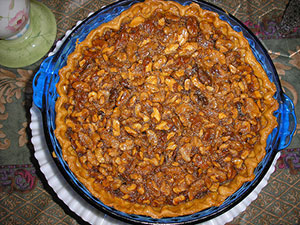By Lisa Swann

Found from the Great Plains eastward and from Georgia to Massachusetts, the black walnut tree prefers rich floodplain soil and usually associates with other hardwoods such as maple, elm and sycamore. Considered somewhat rare, its wood is used for furniture and gun stock. Some thieves have caught on to its value and have posed as arborists and made off with a tree! Growing a full, mature black walnut can take 60 years and a 200-year old tree can fetch tens of thousands of dollars. The story of how this wild crop goes from the forest to your table is told in the American Forests magazine article, “A Wild Crop and Backyard Harvest.” But how does the walnut’s story continue once it arrives in your kitchen?
Fortunately for black walnut lovers, harvest comes in October — right before Thanksgiving. You can substitute black walnuts in many foods that call for English walnuts. There are many recipes for black walnuts, including this simple one for black walnut pie:
Easy Black Walnut Pie

- 1 unbaked 9-inch pastry shell
- 1 cup light corn syrup
- 1/2 cup packed brown sugar
- 1/2 cup sugar
- 3 tablespoons butter
- 3 eggs, lightly beaten
- 1 cup chopped black walnuts
Directions:
- Bring the corn syrup, brown sugar and regular sugar to a boil in a saucepan.
- Just when it boils, remove from heat.
- Stir in the 3 tablespoons of butter and let it cool for three minutes.
- Stir lightly beaten eggs into the mixture, add walnuts and stir well.
- Pour into the pastry shell. Bake at 325° for 55-60 minutes or until top is browned.
Makes 8 servings.